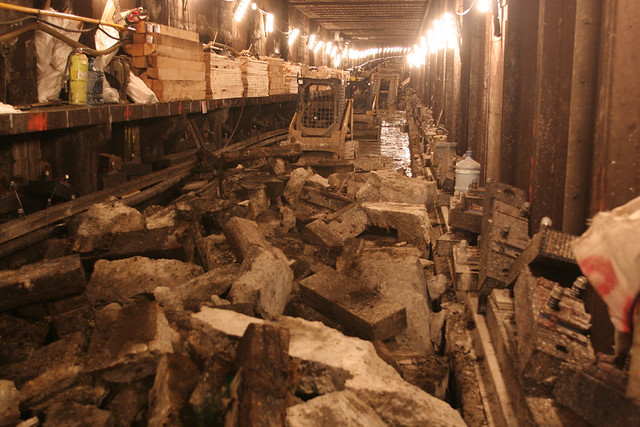New York City recently passed an anniversary it would rather not commemorate for it was the one-year mark of the MTA’s service cuts. On June 28, 2010, as we all know, the MTA slashed two subway lines, rerouting another and cut numerous bus routes in order to cover a substantial budget gap. It was the first time in generations that the MTA had engaged in such extreme across-the-board cuts, and as many representatives in Albany today continue to fight over transit funding, those cuts serve as a real reminder of the power of the legislative pen.
In the ensuing year, things have changed both on the periphery of transit in New York City and in the meaty center. Bus ridership has declined precipitously, and while slow boarding and sluggish surface traffic are certainly to blame, that New Yorkers must now wait longer for buses that aren’t as convenient is a major factor as well. Cut enough service and eventually, people stop showing up.
On other hand, some have had luck in pressuring the MTA to restore service. Last week, facing a lawsuit and political pressure, the MTA revived the X37 and X38, express routes that served Southern Brooklyn. The replacement lines “didn’t really perform as we had anticipated,” an authority spokesperson said.“There was crowding, traffic delays, it was like a loading imbalance, where you’d have one bus that was too crowded and another that was almost empty.” Yet, I still yearn for the B71 as I’ve grown quite familiar with the 20-minute walk from Park Slope to Bar Great Harry on Smith St.
In The Wall Street Journal yesterday, Andrew Grossman took an anecdotal look at those most impacted by the service cuts. The story he tells is a familiar one: Those with the fewest options before the cuts are the most inconvenienced today. He reports:
In the year since the bus that carried Milagros Franco across the Manhattan Bridge was eliminated, the 35-year-old has been getting home from work a different way: She drives her motorized wheelchair across the Brooklyn Bridge. “I could have said, ‘OK, well, I’m quitting my job now,'” she said. “But I get up and do what I have to do.”
…Bus ridership has dropped since the cuts, continuing a years-long trend. Some people who lost their bus lines have gone to the subways, but many have not. “People relied on those because they aren’t capable of getting into the subways,” said Bill Henderson, the executive director of the Permanent Citizens Advisory Council to the MTA. “They tend to be older, they tend to be poorer.”
Pamela Golinski, an attorney who lives on the Upper East Side, used to ride an express bus to her office on Wall Street. After the MTA eliminated the line, she and a fellow rider tried to help a private operator run along the route. But the city shut that down, saying the operator didn’t have the necessary licenses. Now, she either rides a shared taxi that picks up at a stand near her apartment or pays a private van service.
Lois Hecht is driving her 12-year-old Mercedes station wagon more often. Three back surgeries have made it nearly impossible for her to climb the stairs out of the subway. She used to take three buses to get from her home in Prospect Heights to Park Slope, Carroll Gardens or Manhattan to run errands and see movies. She and her husband moved to the neighborhood from the Upper East Side 5½ years ago in part because of the nearby buses. But many of them don’t exist anymore.
This piece highlights those on the fringe, and it doesn’t paint a great portrait of the accessibility of the transit system. People who are too infirm to take the subway because of the stairs at every station used to rely on buses, but now those buses are gone. Access-A-Ride costs will go up in some cases, but in many others, these riders simply won’t take transit any longer.
The ultimate conclusions from the 2010 cuts are tough to draw with only Grossman’s piece. He does note at the end that the elimination of the V and use of the M up Sixth Ave. via the Chrystie St. Cut has been a boon for real estate developers and Middle Village and Bushwick residents, and I’d like to know more about the popularity and success of that switch. From what I’ve heard, it was actually a good one, as a real estate broker said to The Journal. “Absolutely love it,” he said. “We started selling quite strongly before. The fact that they changed the M train only helped me.”
Still, the fight for funding continues, and every time a bus line is eliminated or rerouted, people lose out on options and convenience. That’s not a net positive for anyone in the city.



















 When it comes to ongoing the Second Ave. Subway work, the MTA is facing a mini crisis. Because Albany funded the current capital plan only through the end of the year and has yet to address 2012-2014, there is a slight chance that the MTA will have to freeze some big-ticket items if the politicians do not come through. Recently, the MTA has taken to
When it comes to ongoing the Second Ave. Subway work, the MTA is facing a mini crisis. Because Albany funded the current capital plan only through the end of the year and has yet to address 2012-2014, there is a slight chance that the MTA will have to freeze some big-ticket items if the politicians do not come through. Recently, the MTA has taken to 

